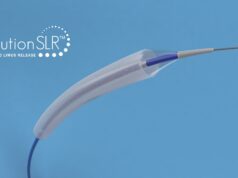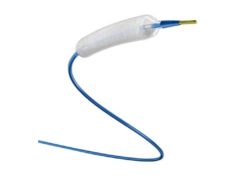
Twelve-month results of the CONSEQUENT trial have shown lower late lumen loss, lower rates of 12-month target lesion revascularisation and longer walking distance increases for patients treated with the SeQuent drug-coated balloon (B Braun) compared with plain balloon angioplasty.
The trial, the outcomes of which were presented by Thomas Albrecht (Vivantes Klinikum Neukölln, Berlin, Germany) at the 2017 Leipzig Interventional Course (LINC; 24–27 January, Leipzig, Germany), featured the longest lesions (mean of 13.2cm) of any other previously-published drug-coated balloon trial in a Caucasian patient population.
The CONSEQUENT trial focused on treatment of the superficial femoral artery and the first two segments of the popliteal arteries, and included post-plain balloon angioplasty patients with Rutherford classification 2–4, reference vessel diameters 4–7mm and lesion lengths 4–27cm. Pre-procedural stenosis diameter had to be ≥70%, and patients needed adequate runoff with at least one vessel to the foot. Patients were excluded if restenosis was following stent placement or drug-coated balloon placement, if there were more than two lesions in the target vessel or if they had chronic total occlusions longer than 10cm.
The trial enrolled 153 patients (78 for drug-coated balloon and 75 for plain balloon) with an age of 68.1±8.7 years. All baseline patient characteristics, with the exception of a higher proportion of males in the plain balloon group (76% vs. 60.3%) were similar for both groups. All patients were in Rutherford class 2 or 3. For both groups, the superficial femoral artery was the most common lesion location (79.7% overall, 80.8% for the drug-coated balloon group and 78.7% for the plain balloon group). The popliteal artery was treated for 5.9% of patients (5.1% in the drug-coated balloon group and 6.7% in the plain balloon group). Both the superficial femoral and popliteal arteries were treated in 14.4% of patients (14.1% in the drug-coated balloon patients and 14.7% of plain balloon patients) (p=0.91 for all).
TASC C lesions were treated in 17% of patients (16.7% of drug-coated balloon patients and 17.3% of plain balloon patients), while TASC D lesions were treated in 6.5% of patients (7.7% in the drug-coated balloon group and 5.3% in the plain balloon group). Combined, TASC A (35.3%) and B (41.2%) accounted for the majority of the treated lesions (p=0.93 for all).
Lesion length was notably long, at 13.2±10.4cm overall (13.7±12.2cm for the drug-coated balloon group and 12.6±8.2cm for the plain balloon group; p=0.54).
Predilatation was employed in 55.6% of cases (52.6% for drug-coated balloon patients and 58.7% of plain balloon patients; p=0.44), while bailout stenting was used in 16.3% of cases (14.1% of drug-coated balloon patients and 18.7% of plain balloon patients; p=0.44).
Angiographic six-month data were taken from the 73% of target lesions available for follow-up (69.2% in the drug-coated balloon group and 77.3% in the plain balloon group). Late lumen loss was 0.73±1mm for all patients, though it was significantly lower for the drug-coated balloon patients (0.35mm) compared with plain balloon patients (0.72mm) (p=0.006). Positive remodelling was seen in 25% of all patients, though once again the drug-coated balloon patients posted better results (35.2%) when compared with their plain balloon counterparts (15.5%) (p=0.016). Binary restenosis >50% was reported in 33% of all patients (22.2% of drug-coated balloon patients and 43.1% of plain balloon patients; p=0.019).
Six-month target lesion revascularisation was 9% for the drug-coated balloon patients, compared with 31% for plain balloon patients (p=0.001). Increase in walking distance was almost twice as good for drug-coated balloon patients compared with plain balloon patients, at 137±160m and 71±130m, respectively (p=0.039). Target leg ankle brachial index was 0.96±0.14 for the drug-coated balloon group, slightly higher than the 0.89±0.21 reported for the plain balloon patients (0.043).
Albrecht also presented the 12-month clinical results, which showed continued drug-coated balloon superiority. Target lesion revascularisation was seen in 18% of drug-coated balloon patients and 38% of plain balloon patients (p=0.008). Binary restenosis (>50%) was present in 28% of drug-coated balloon patients and 54% of plain balloon patients (p=0.002). Increase in walking distance remained significantly higher in the drug-coated balloon group, at 165±105m compared with 94±136m for plain balloon patients. The 12-month Rutherford category shift for drug-coated balloon patients was 2.5±1, while for plain balloon patients it was 1.8±1.3 (p=0.01). The target leg ankle brachial index was no longer significant at 12 months (0.91±0.20 for drug-coated balloon and 0.91±0.25 for plain balloon; p=0.96).
Albrecht concluded that the six- and 12-month results of this trial show that the outcomes for the drug-coated balloon cohort were superior to those of the plain balloon patients, both by clinical and angiographic criteria. “Late lumen loss, which was the primary endpoint of this study was significantly lower in the drug-coated balloon group, we had lower 12-month target lesion revascularisation in the drug-coated balloon group, a longer walking distance and an increase in improvement in Rutherford categories,” Albrecht said. The next stage of follow-up will be conducted at 24 months.













